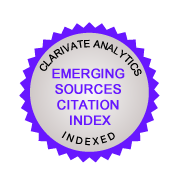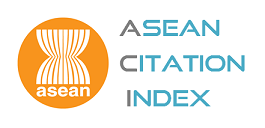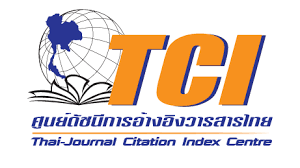Synthesis temperature-driven enhancements in BiOI photocatalysis: A hydrothermal approach
DOI:
https://doi.org/10.55713/jmmm.v35i3.2318Keywords:
Bismuth oxoiodide (BiOI), Hydrothermal synthesis, Photocatalysis, Visible light, Indigo carmine degradation, Wastewater treatmentAbstract
Bismuth oxyiodide (BiOI) is a promising photocatalyst for visible-light-driven environmental remediation. However, its photocatalytic efficiency is highly dependent on synthesis conditions, particularly hydrothermal temperature, which governs its structural, optical, and electronic properties. In this study, BiOI was synthesized via a hydrothermal method at temperatures of 120℃, 150℃, 180℃, and 210℃ to investigate the effect of temperature on its photocatalytic performance systematically. Comprehensive characterizations, including X-ray diffraction, field emission scanning electron microscopy, energy-dispersive X-ray spectroscopy, Fourier-transform infrared spectroscopy, UV-vis diffuse reflectance spectroscopy, photoluminescence and photocatalytic degradation studies, were conducted to analyze crystallinity, morphology, band structure and charge transfer properties. The results demonstrated that BiOI synthesized at 180℃ exhibited an optimal combination of crystallinity and particle dispersion, which enhanced charge separation and photocatalytic activity. It achieved a degradation efficiency of 94% for indigo carmine within 60 min under visible light irradiation. The bandgap energy and electronic structure of BiOI played a critical role in determining the dominant reactive species, with superoxide radicals (•O2−) being the primary contributors to indigo carmine degradation. The study provides new insights into the relationship between synthesis temperature, structural evolution, and photocatalytic efficiency, offering a scalable and effective approach for optimizing BiOI-based photocatalysts for environmental applications.
Downloads
References
S. Jang, S. Song, J. H. Lim, H. S. Kim, B. T. Phan, K.-T. Ha, S. Park, and K. H. Park, "Application of various metal-organic frameworks (MOFs) as catalysts for air and water pollution environmental remediation," Catalysts, vol. 10, no. 2, 2020. DOI: https://doi.org/10.3390/catal10020195
O. Al-Madanat, Y. AlSalka, W. Ramadan, and D. W. Bahnemann, "TiO2 photocatalysis for the transformation of aromatic water pollutants into fuels," Catalysts, vol. 11, no. 3, 2021. DOI: https://doi.org/10.3390/catal11030317
K. Singsumphan, C. Suwanchawalit, W. Somsorod, T. Sripathomkul, P. Sawanglap, K. Aiempanakit, and M. Aiempanakit, “Low-voltage electrophoretic deposition of silver nanoparticles on ZnO nanorods thin films for enhanced visible-light photo-catalysis,” Optik, vol. 322, p. 172179, 2025. DOI: https://doi.org/10.1016/j.ijleo.2024.172179
Y. Pi, X. Li, Q. Xia, J. Wu, Y. Li, J. Xiao, and Z. Li, “Adsorptive and photocatalytic removal of persistent organic pollutants (POPs) in water by metal-organic frameworks (MOFs),” Chemical Engineering Journal, vol. 337, pp. 351-371, 2018. DOI: https://doi.org/10.1016/j.cej.2017.12.092
A. Talaiekhozani, S. Rezania, K.-H. Kim, R. Sanaye, and A. M. Amani, “Recent advances in photocatalytic removal of organic and inorganic pollutants in air,” Journal of Cleaner Production, vol. 278, p. 123895, 2021. DOI: https://doi.org/10.1016/j.jclepro.2020.123895
K. Wirandorn, N. Panyayao, and V. Siriwongrungson, “Characterization and photocatalytic activity of titanium dioxide deposited on stainless steel by pulsed-pressure MOCVD,” Journal of Metals, Materials and Minerals, vol. 28, pp. 76-82, 2018.
M. Aiempanakit, J. Sangkaworn, N. Worawannotai, K. Laohhasurayotin, W. Sangchay, S. Laksee, and C. Suwanchawalit, “Enhancement of visible light-responsive photocatalytic efficiency by using a laccaic acid-modified titanium dioxide photocatalyst,” Journal of the Brazilian Chemical Society, vol. 33, 2022. DOI: https://doi.org/10.21577/0103-5053.20220006
F. Opoku, K. K. Govender, C. G. C. E. van Sittert, and P. P. Govender, “Recent progress in the development of semi-conductor-based photocatalyst materials for applications in photocatalytic water splitting and degradation of pollutants,” Advanced Sustainable Systems, vol. 1, no. 7, p. 1700006, 2017. DOI: https://doi.org/10.1002/adsu.201700006
X. Ren, J. Yao, L. Cai, J. Li, X. Cao, Y. Zhang, B. Wang, and Y. Wei, “Band gap engineering of BiOI via oxygen vacancies induced by graphene for improved photocatalysis,” New Journal of Chemistry, vol. 43, no. 3, pp. 1523-1530, 2019. DOI: https://doi.org/10.1039/C8NJ05538F
H. Liu, W. Cao, Y. Su, Y. Wang, and X. Wang, “Synthesis, characterization and photocatalytic performance of novel visible-light-induced Ag/BiOI,” Applied Catalysis B: Environmental, vol. 111-112, pp. 271-279, 2012. DOI: https://doi.org/10.1016/j.apcatb.2011.10.008
S. Singh, R. Sharma, and M. Khanuja, “A review and recent developments on strategies to improve the photocatalytic elimination of organic dye pollutants by BiOX (X=Cl, Br, I, F) nanostructures,” Korean Journal of Chemical Engineering, vol. 35, no. 10, pp. 1955-1968, 2018. DOI: https://doi.org/10.1007/s11814-018-0112-y
M. Arumugam, and M. Y. Choi, “Recent progress on bismuth oxyiodide (BiOI) photocatalyst for environmental remediation,” Journal of Industrial and Engineering Chemistry, vol. 81, pp. 237-268, 2020. DOI: https://doi.org/10.1016/j.jiec.2019.09.013
M. R. Elamin, K. H. Ibnaouf, N. Y. Elamin, F. A. Adam, A. H. Alolayan, and B. Y. Abdulkhair, "Spontaneous adsorption and efficient photodegradation of indigo carmine under visible light by bismuth oxyiodide nanoparticles fabricated entirely at room temperature," Inorganics, 10, 2022. DOI: https://doi.org/10.3390/inorganics10050065
Y. Bu, J. Xu, Y. Li, Q. Liu, and X. Zhang, “Enhanced photo-catalytic activity of BiOI under visible light irradiation by the modification of MoS2,” RSC Advances, vol. 7, no. 67, pp. 42398-42406, 2017.
M. Chakraborty, K. K. Bera, S. Chatterjee, A. Ghosh, and S. K. Bhattacharya, “Synthesis of mesoporous BiOI flower and facile in-situ preparation of BiOI/BiOCl mixture for enhanced photo-catalytic degradation of toxic dye, Rhodamine-B,” Journal of Photochemistry and Photobiology, vol. 8, p. 100077, 2021. DOI: https://doi.org/10.1016/j.jpap.2021.100077
J.-w. Zhao, Z.-q. Wei, S.-p. Huang, L. Li, and J.-h. Ma, “Photo-catalytic properties of bismuth oxyiodide nanomaterials with different morphologies,” Desalination and Water Treatment, vol. 281, pp. 287-295, 2023. DOI: https://doi.org/10.5004/dwt.2023.29150
W. W. Lee, C.-S. Lu, C.-W. Chuang, Y.-J. Chen, J.-Y. Fu, C.-W. Siao, and C.-C. Chen, “Synthesis of bismuth oxyiodides and their composites: characterization, photocatalytic activity, and degradation mechanisms,” RSC Advances, vol. 5, no. 30, pp. 23450-23463, 2015. DOI: https://doi.org/10.1039/C4RA15072D
H. Liu, C. Yang, J. Huang, J. Chen, J. Zhong, and J. Li, “Ionic liquid-assisted hydrothermal preparation of BiOI/BiOCl hetero-junctions with enhanced separation efficiency of photogenerated charge pairs and photocatalytic performance,” Inorganic Chemistry Communications, vol. 113, p. 107806, 2020. DOI: https://doi.org/10.1016/j.inoche.2020.107806
D. Ke, T. Peng, L. Ma, P. Cai, and K. Dai, “Effects of hydro-thermal temperature on the microstructures of BiVO4 and Its photocatalytic O2 evolution activity under visible light,” Inorganic Chemistry, vol. 48, no. 11, pp. 4685-4691, 2009. DOI: https://doi.org/10.1021/ic900064m
S. Wang, Y. Guan, L. Wang, W. Zhao, H. He, J. Xiao, S. Yang, and C. Sun, “Fabrication of a novel bifunctional material of BiOI/Ag3VO4 with high adsorption–photocatalysis for efficient treatment of dye wastewater,” Applied Catalysis B: Environmental, vol. 168-169, pp. 448-457, 2015. DOI: https://doi.org/10.1016/j.apcatb.2014.12.047
B. Q. L. Low, W. Jiang, J. Yang, M. Zhang, X. Wu, H. Zhu, H. Zhu, J. Z. X. Heng, K. Y. Tang, W.-Y. Wu, X. Cao, X. Q. Koh, C. H. T. Chai, C. Y. Chan, Q. Zhu, M. Bosman, Y.-W. Zhang, M. Zhao, Z. Li, X. J. Loh, Y. Xiong, and E. Ye, “2D/2D heterojunction of BiOBr/BiOI nanosheets for in situ H2O2 production and activation toward efficient photocatalytic waste-
water treatment,” Small Methods, vol. 8, no. 3, p. 2301368, 2024.
M. Yusoff, S. Imam, I. Shah, and R. Adnan, “Photocatalytic activity of bismuth oxyiodide nanospheres and nanoplates in the degradation of ciprofloxacin under visible light,” Materials Research Express, vol. 6, 2019. DOI: https://doi.org/10.1088/2053-1591/ab2918
J. Florez, M. A. Santana Aranda, J. G. Quiñones-Galván, A. Escobedo Morales, A. Chavez Chavez, and A. Pérez-Centeno, “Alternative Bi precursor effects on the structural, optical, morphological and photocatalytic properties of BiOI nano-structures,” Materials Research Express, vol. 7, p. 015912, 2020. DOI: https://doi.org/10.1088/2053-1591/ab677b
T. Gupta, Samriti, J. Cho, and J. Prakash, “Hydrothermal synthesis of TiO2 nanorods: formation chemistry, growth mechanism, and tailoring of surface properties for photo-catalytic activities,” Materials Today Chemistry, vol. 20, p. 100428, 2021. DOI: https://doi.org/10.1016/j.mtchem.2021.100428
X.-D. Dong, Y.-M. Zhang, and Z.-Y. Zhao, “Role of the polar electric field in bismuth oxyhalides for photocatalytic water splitting,” Inorganic Chemistry, vol. 60, no. 12, pp. 8461-8474, 2021. DOI: https://doi.org/10.1021/acs.inorgchem.0c03220
R. He, S. Cao, J. Yu, and Y. Yang, “Microwave-assisted solvo-thermal synthesis of Bi4O5I2 hierarchical architectures with high photocatalytic performance,” Catalysis Today, vol. 264, 2015. DOI: https://doi.org/10.1016/j.cattod.2015.07.029
H. Li, Q. Jia, Y. Cui, and S. Fan, “Photocatalytic properties of BiOI synthesized by a simple hydrothermal process,” Materials Letters, vol. 107, pp. 262-264, 2013. DOI: https://doi.org/10.1016/j.matlet.2013.06.019
Z. Zulkifli, K. Razak, and W. Rahman, The effect of reaction temperature on the particle size of bismuth oxide nanoparticles synthesized via hydrothermal method, 2018. DOI: https://doi.org/10.1063/1.5034538
F. Huang, H. Zhang, and J. F. Banfield, “Two-stage crystal-growth kinetics observed during hydrothermal coarsening of nano-crystalline ZnS,” Nano Letters, vol. 3, no. 3, pp. 373-378, 2003. DOI: https://doi.org/10.1021/nl025836+
M. Aiempanakit, P. Sudjai, K. Singsumphan, S. Laksee, and C. Suwanchawalit, “Brazilein modified zinc oxide nanorods with enhanced visible light-responsive photocatalytic efficiency,” Journal of Metals, Materials and Minerals, vol. 32, pp. 70-76, 2022. DOI: https://doi.org/10.55713/jmmm.v32i2.1255
Y.-S. Cho, H. J. Lee, and S. Sung, “Photocatalytic degradation of methylene blue using three-dimensional porous graphene-titania microparticles under UV light,” Korean Journal of Chemical Engineering, vol. 37, no. 6, pp. 1071-1085, 2020. DOI: https://doi.org/10.1007/s11814-020-0512-7
A. C. Mera, Y. Moreno, D. Contreras, N. Escalona, M. F. Meléndrez, R. V. Mangalaraja, and H. D. Mansilla, “Improvement of the BiOI photocatalytic activity optimizing the solvothermal synthesis,” Solid State Sciences, vol. 63, pp. 84-92, 2017. DOI: https://doi.org/10.1016/j.solidstatesciences.2016.11.013
H. H. Yang, K.-Y. Hsiao, F.-Y. Liu, C.-C. Chen, and I. C. Chen, “Vibrational structures of iodine-vacancy bismuth oxyiodides using temperature-dependent low-wavenumber raman spectro-scopy,” The Journal of Physical Chemistry C, vol. 128, no. 1, pp. 563-570, 2024. DOI: https://doi.org/10.1021/acs.jpcc.3c06627
A. C. Mera, C. Rodríguez, M. Meléndrez, and H. Valdes, “Synthesis and characterization of BiOI microspheres under standardized conditions,” Journal of Materials Science, vol. 52, 2017. DOI: https://doi.org/10.1007/s10853-016-0390-x
S. Bhattacharjee, C. R. Macintyre, X. Wen, P. Bahl, U. Kumar, A. A. Chughtai, and R. Joshi, “Nanoparticles incorporated graphene-based durable cotton fabrics,” Carbon, vol. 166, pp. 148-163, 2020. DOI: https://doi.org/10.1016/j.carbon.2020.05.029
J. Wang, M. Zhang, J. Meng, Q. Li, and J. Yang, “Single- and few-layer BiOI as promising photocatalysts for solar water splitting,” RSC Advances, vol. 7, no., pp. 24446-24452, 2017. DOI: https://doi.org/10.1039/C7RA01723E
A. C. Mera, A. Martínez-de la Cruz, E. Pérez-Tijerina, M. F. Meléndrez, and H. Valdés, “Nanostructured BiOI for air pollution control: Microwave-assisted synthesis, characterization and photocatalytic activity toward NO transformation under visible light irradiation,” Materials Science in Semiconductor Processing, vol. 88, pp. 20-27, 2018. DOI: https://doi.org/10.1016/j.mssp.2018.04.045
M. Riebe, D. Foustoukos, C. Alexander, A. Steele, G. Cody, B. Mysen, and L. Nittler, The effects of atmospheric entry heating on organic matter in interplanetary dust particles, 2020. DOI: https://doi.org/10.1016/j.epsl.2020.116266
J. Bai, J. Sun, X. Zhu, J. Liu, H. Zhang, X.-B. Yin, and L. Liu, “Enhancement of solar-driven photocatalytic activity of bioi nanosheets through predominant exposed high energy facets and vacancy engineering,” Small, vol. 16, no. 5, p. 1904783, 2020. DOI: https://doi.org/10.1002/smll.201904783
L. Dou, D. Ma, J. Chen, J. Li, and J. Zhong, “F127-assisted hydrothermal preparation of BiOI with enhanced sunlight-driven photocatalytic activity originated from the effective separation of photo-induced carriers,” Solid State Sciences, vol. 90, pp. 1-8, 2019. DOI: https://doi.org/10.1016/j.solidstatesciences.2019.01.010
L. Ye, K. Deng, F. Xu, L. Tian, T. Peng, and L. Zan, “Increasing visible-light absorption for photocatalysis with black BiOCl,” Physical Chemistry Chemical Physics, vol. 14, no. 1, pp. 82-85, 2012. DOI: https://doi.org/10.1039/C1CP22876E
J. Li, J. Zhong, Y. Si, S. Huang, L. Dou, M. Li, Y. Liu, and J. Ding, “Improved solar-driven photocatalytic performance of BiOI decorated TiO2 benefiting from the separation properties of photo-induced charge carriers,” Solid State Sciences, vol. 52, pp. 106-111, 2016. DOI: https://doi.org/10.1016/j.solidstatesciences.2015.12.020
Y. Bu, J. Xu, Y. Li, Q. Liu, and X. Zhang, “Enhanced photo-catalytic activity of BiOI under visible light irradiation by the modification of MoS2,” RSC Advances., vol. 7, pp. 42398-42406, 2017. DOI: https://doi.org/10.1039/C7RA06462D
S. K. Ray, D. Dhakal, and S. W. Lee, “Visible light driven Ni–BaMo3O10 photocatalyst for indigo carmine degradation: mechanism and pathways,” Materials Science in Semiconductor Processing, vol. 105, p. 104697, 2020. DOI: https://doi.org/10.1016/j.mssp.2019.104697
A. K. Subramani, K. Byrappa, S. Ananda, K. M. Lokanatha Rai, C. Ranganathaiah, and M. Yoshimura, “Photocatalytic degradation of indigo carmine dye using TiO2 impregnated activated carbon,” Bulletin of Materials Science, vol. 30, no. 1, pp. 37-41, 2007. DOI: https://doi.org/10.1007/s12034-007-0007-8
C. Sánchez Trinidad, A. Martínez-de la Cruz, and E. López Cuéllar, “Photocatalytic degradation of indigo carmine by hydrothermally synthesized Bi2MoO6 in presence of EDTA,” Environmental Science and Pollution Research, vol. 22, no. 2, pp. 792-799, 2015. DOI: https://doi.org/10.1007/s11356-014-3004-7
P. Intaphong, A. Phuruangrat, S. Thongtem, and T. Thongtem, “Sonochemical synthesis and characterization of BiOI nano-plates for using as visible-light-driven photocatalyst,” Materials Letters, vol. 213, pp. 88-91, 2018. DOI: https://doi.org/10.1016/j.matlet.2017.11.014
Q. Wang, H. Wu, Q. Gao, D. Lin, Y. Fan, R. Duan, Y. Cong, and Y. Zhang, “Fabrication of visible-light-active Bi/BiOI-Bi2O3 composite with enhanced photocatalytic activity,” Journal of Colloid and Interface Science, vol. 548, pp. 255-264, 2019. DOI: https://doi.org/10.1016/j.jcis.2019.04.044
J. Shi, X. Zhao, and C. Li, "Surface passivation engineering for photoelectrochemical water splitting," Catalysts, 13, 2023. DOI: https://doi.org/10.3390/catal13020217

Downloads
Published
How to Cite
License
Copyright (c) 2025 Journal of Metals, Materials and Minerals

This work is licensed under a Creative Commons Attribution-NonCommercial-NoDerivatives 4.0 International License.
Authors who publish in this journal agree to the following terms:
- Authors retain copyright and grant the journal right of first publication with the work simultaneously licensed under a Creative Commons Attribution License that allows others to share the work with an acknowledgment of the work's authorship and initial publication in this journal.
- Authors are able to enter into separate, additional contractual arrangements for the non-exclusive distribution of the journal's published version of the work (e.g., post it to an institutional repository or publish it in a book), with an acknowledgment of its initial publication in this journal.












